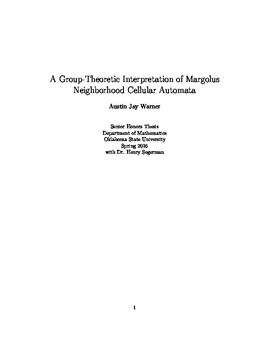| dc.contributor.author | Warner, Austin Jay | |
| dc.date.accessioned | 2017-10-10T20:57:16Z | |
| dc.date.available | 2017-10-10T20:57:16Z | |
| dc.date.issued | 2016-08-03 | |
| dc.identifier | oksd_warner_HT_2016 | |
| dc.identifier.uri | https://hdl.handle.net/11244/52365 | |
| dc.description.abstract | A set-theoretic structure of Margolus neighborhood cellular automata is developed to accommodate a group structure in an intuitive way. It is proven that pairs of reversible Margolus rule-global maps generate a group of bijections on a finite 2n x 2m grid of binary cells with function composition. This group can further be understood as a group action on the grid. We focus on the subgroup that consists of pairs of reversible, conservative rules and, in particular, the action of this group on the set of all possible "lonely universes" (grids with one living cell). We examine the permutation representation of this action and compute the sizes of the subgroups that are the isomorphic copies of the group under the permutation representation map. | |
| dc.format | application/pdf | |
| dc.language | en_US | |
| dc.rights | Copyright is held by the author who has granted the Oklahoma State University Library the non-exclusive right to share this material in its institutional repository. Contact Digital Library Services at lib-dls@okstate.edu or 405-744-9161 for the permission policy on the use, reproduction or distribution of this material. | |
| dc.title | Group-theoretic interpretation of Margolus neighborhood cellular automata | |
| osu.filename | oksd_warner_HT_2016.pdf | |
| osu.accesstype | Open Access | |
| dc.type.genre | Honors Thesis | |
| dc.type.material | Text | |
| dc.contributor.director | Segerman, Henry | |
| dc.contributor.facultyreader | Barchini, Leticia I. | |
| thesis.degree.discipline | Mathematics | |
| thesis.degree.grantor | Oklahoma State University | |
